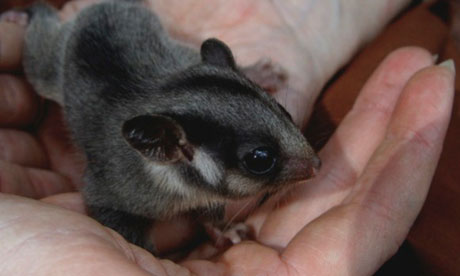The Sydney Morning Herald, 10/12/13
Animals are going extinct and millions of dollars in Australian endangered species funding are being squandered because of poor planning and monitoring, leading environmental scientists say.
If data on the welfare of an endangered species is collected, it is rarely analysed or acted on, said David Lindenmayer, one of the authors of an article in the journal Frontiers in Ecology and the Environment. "Usually [monitoring] is the last thing funded and the first thing cut," said Professor Lindenmayer, an ecologist at the Australian National University. "It's quite shambolic, this whole area."
Things might be going well, they might be going badly. We'd never know
In Australia, only five of the 122 recovery plans for 191 listed species had defined ''trigger points'' for intervention in the event that an animal's population numbers or range dropped, the paper found.
One of those five species - the Christmas Island pipistrelle - had its status triggered to critically endangered after its population dived but the change made little difference and the bat is now believed to be extinct.
The greater glider was one example of a species monitored to local extinction. The marsupial was common in Booderee National Park in southern NSW when tracking began in 2003. By 2005 its population had dropped significantly and two years later it was gone entirely.
The original program had no trigger points requiring action even though the yellow-bellied glider had gone extinct in the park in the 1980s, the authors said in their paper, "Counting the books while the library burns".
The greater glider has also become extinct in Booderee. Photo: Taronga Zoo
Even where triggers for action exist - such as for Victoria's endangered fauna emblem, the Leadbeater's possum - the state government failed to act, Professor Lindenmayer said.
"Their plan of action is no action," he said.
Leaving it to the last 20-30 individual animals before acting was inefficient economically and ecologically, Professor Lindenmayer said. "You have to start doing very expensive things that are nearly always prone to failure, such as captive breeding."
Government programs without sufficient monitoring and action points included the National Heritage Trust and its successor body, Caring for our Country. The situation is even worse where mining and energy companies, and farmers, were left to monitor their own environmental damage.
"Things might be going well, they might be going badly. We'd never know," Professor Lindenmayer said.
Examples of successful programs include efforts to reduce the fox threat to species such as the eastern bristlebird in the Jervis Bay area and the yellow-footed rock wallaby in the Flinders Ranges.
When species become extinct, authorities should compile obituaries so lessons are learnt to help save other creatures at risk, Professor Lindenmayer said.
Animals are going extinct and millions of dollars in Australian endangered species funding are being squandered because of poor planning and monitoring, leading environmental scientists say.
If data on the welfare of an endangered species is collected, it is rarely analysed or acted on, said David Lindenmayer, one of the authors of an article in the journal Frontiers in Ecology and the Environment. "Usually [monitoring] is the last thing funded and the first thing cut," said Professor Lindenmayer, an ecologist at the Australian National University. "It's quite shambolic, this whole area."
Things might be going well, they might be going badly. We'd never know
In Australia, only five of the 122 recovery plans for 191 listed species had defined ''trigger points'' for intervention in the event that an animal's population numbers or range dropped, the paper found.
One of those five species - the Christmas Island pipistrelle - had its status triggered to critically endangered after its population dived but the change made little difference and the bat is now believed to be extinct.
The greater glider was one example of a species monitored to local extinction. The marsupial was common in Booderee National Park in southern NSW when tracking began in 2003. By 2005 its population had dropped significantly and two years later it was gone entirely.
The original program had no trigger points requiring action even though the yellow-bellied glider had gone extinct in the park in the 1980s, the authors said in their paper, "Counting the books while the library burns".
The greater glider has also become extinct in Booderee. Photo: Taronga Zoo
Even where triggers for action exist - such as for Victoria's endangered fauna emblem, the Leadbeater's possum - the state government failed to act, Professor Lindenmayer said.
"Their plan of action is no action," he said.
Leaving it to the last 20-30 individual animals before acting was inefficient economically and ecologically, Professor Lindenmayer said. "You have to start doing very expensive things that are nearly always prone to failure, such as captive breeding."
Government programs without sufficient monitoring and action points included the National Heritage Trust and its successor body, Caring for our Country. The situation is even worse where mining and energy companies, and farmers, were left to monitor their own environmental damage.
"Things might be going well, they might be going badly. We'd never know," Professor Lindenmayer said.
Examples of successful programs include efforts to reduce the fox threat to species such as the eastern bristlebird in the Jervis Bay area and the yellow-footed rock wallaby in the Flinders Ranges.
When species become extinct, authorities should compile obituaries so lessons are learnt to help save other creatures at risk, Professor Lindenmayer said.












